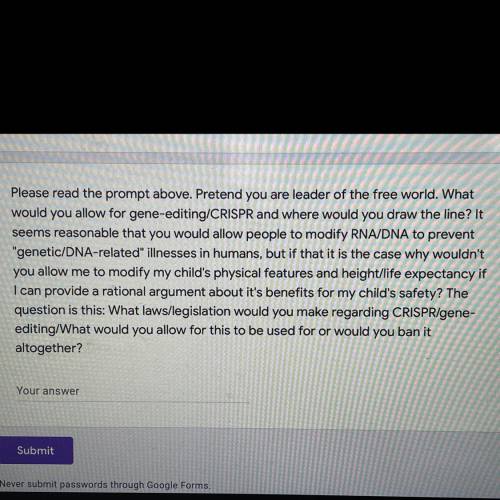
Computers and Technology, 22.06.2021 17:10 niele123
Many advocates for GENE editing/CRISPR make the argument that it is useful
in preventing diseases in humans/animals that are "genetic/DNA-related", but
where is the line drawn? If I am a parent that wants to make my unborn baby
6"4 or increase my child's life expectancy and I make the argument that it's for
my child's safety as the bigger my child is, the less inclined they will be
challenged to physical fights as they grow older - should this be allowed?
What if someone decided to make human-animal hybrids (it is possible) in the
name of "to make humans more resistant to certain illnesses"? Should this be
allowed? What if you hate the idea gene-editing and would like to BAN it
altogether - what would you do about vaccines? Many vaccines in the real-
world (today) modify one's RNA which store genetical information (extremely
similar to DNA) - where do you draw the line?


Answers: 2


Other questions on the subject: Computers and Technology

Computers and Technology, 23.06.2019 06:40, euniceyi56
How many nibbles can be stored in a 16-bit word?
Answers: 1

Computers and Technology, 23.06.2019 14:00, allison9746
Need ! will choose brainliest! discuss the role of abstraction in the history of computer software.
Answers: 1

Computers and Technology, 23.06.2019 17:30, Annlee23
When making changes to optimize part of a processor, it is often the case that speeding up one type of instruction comes at the cost of slowing down something else. for example, if we put in a complicated fast floating-point unit, that takes space, and something might have to be moved farther away from the middle to accommodate it, adding an extra cycle in delay to reach that unit. the basic amdahl's law equation does not take into account this trade-off. a. if the new fast floating-point unit speeds up floating-point operations by, on average, 2ă—, and floating-point operations take 20% of the original program's execution time, what is the overall speedup (ignoring the penalty to any other instructions)? b. now assume that speeding up the floating-point unit slowed down data cache accesses, resulting in a 1.5ă— slowdown (or 2/3 speedup). data cache accesses consume 10% of the execution time. what is the overall speedup now? c. after implementing the new floating-point operations, what percentage of execution time is spent on floating-point operations? what percentage is spent on data cache accesses?
Answers: 2

Computers and Technology, 24.06.2019 07:00, janeliles
Why would a business likely use a java applet - to back up their data files for the business - to create a program that a customer can launch in their web browser - to create music on a powerpoint presentation - to organize files on their company directory
Answers: 3
You know the right answer?
Many advocates for GENE editing/CRISPR make the argument that it is useful
in preventing diseases i...
Questions in other subjects:


History, 13.02.2021 21:30

Mathematics, 13.02.2021 21:30


Mathematics, 13.02.2021 21:30



Mathematics, 13.02.2021 21:30




